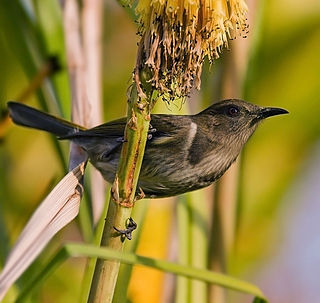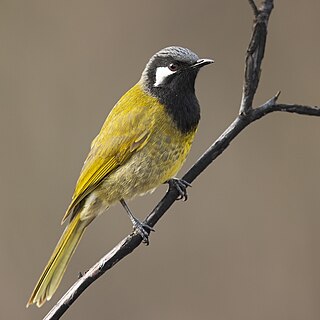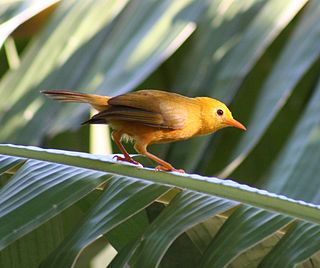
The honeyeaters are a large and diverse family, Meliphagidae, of small to medium-sized birds. The family includes the Australian chats, myzomelas, friarbirds, wattlebirds, miners and melidectes. They are most common in Australia and New Guinea, and found also in New Zealand, the Pacific islands as far east as Samoa and Tonga, and the islands to the north and west of New Guinea known as Wallacea. Bali, on the other side of the Wallace Line, has a single species.

The red wattlebird is a passerine bird native to southern Australia. At 33–37 cm in length, it is the second largest species of Australian honeyeater. It has mainly grey-brown plumage, with red eyes, distinctive pinkish-red wattles on either side of the neck, white streaks on the chest and a large bright yellow patch on the lower belly. The sexes are similar in plumage. Juveniles have less prominent wattles and browner eyes. John White described the red wattlebird in 1790. Three subspecies are recognized.

The blue-faced honeyeater, also colloquially known as the bananabird, is a passerine bird of the honeyeater family, Meliphagidae. It is the only member of its genus, and it is most closely related to honeyeaters of the genus Melithreptus. Three subspecies are recognised. At around 29.5 cm (11.6 in) in length, the blue-faced species is large for a honeyeater. Its plumage is distinctive, with olive upperparts, white underparts, and a black head and throat with white nape and cheeks. Males and females are similar in external appearance. Adults have a blue area of bare skin on each side of the face readily distinguishing them from juveniles, which have yellow or green patches of bare skin.

The scarlet myzomela or scarlet honeyeater is a small passerine bird of the honeyeater family Meliphagidae native to Australia. It was first described by English ornithologist John Latham in 1801. At 9 to 11 centimetres long, it is the smallest honeyeater in Australia. It has a short tail and relatively long down-curved bill. It is sexually dimorphic; the male is a striking bright red with black wings, while the female is entirely brown. The species is more vocal than most honeyeaters, and a variety of calls have been recorded, including a bell-like tinkling.

The white-naped honeyeater is a passerine bird of the honeyeater family Meliphagidae native to eastern Australia. Birds from southwestern Australia have been shown to be a distinct species, Gilbert's honeyeater, and the eastern birds are more closely related to the black-headed honeyeater of Tasmania. One of several similar species of black-headed honeyeaters in the genus Melithreptus, it dwells in dry sclerophyll eucalypt woodland. Its diet consists of nectar from various flowers, and it also feeds on insects.

The white-eared honeyeater is a medium-sized honeyeater found in Australia. It is a member of the family Meliphagidae which has 190 recognised species with about half of them found in Australia. This makes them members of the most diverse family of birds in Australia. White-eared honeyeaters are easily identifiable by their olive-green body, black head and white ear-patch.

The Bonin white-eye or meguro (メグロ) is a small songbird endemic to the Bonin Islands of Japan. It is the only species in the genus Apalopteron. Its taxonomic affinities were a long-standing mystery and it has been placed with the bulbuls, babblers and more recently with the honeyeaters, during which it was known as the Bonin honeyeater. Since 1995 it is known to be a white-eye in the family Zosteropidae, that is closely related to the golden white-eye of the Marianas Islands.

The striped honeyeater is a passerine bird of the honeyeater family, Meliphagidae, found in Australia. It is a medium-sized honeyeater, about 23 centimetres (9.1 in) in length. Both sexes are a light greyish brown with dark brown centres to the feathers, which give the appearance of stripes. The stripes are particularly distinct on the head and back of the neck. While it is found mainly in inland eastern Australia where it inhabits the drier open forest, it is also found in coastal swamp forest from southeast Queensland to the central coast of New South Wales.

The black honeyeater is a species of bird in the honeyeater family Meliphagidae and the sole species in the genus Sugomel. The black honeyeater exhibits sexual dimorphism, with the male being black and white while the female is a speckled grey-brown; immature birds look like the female. The species is endemic to Australia, and ranges widely across the arid areas of the continent, through open woodland and shrubland, particularly in areas where the emu bush and related species occur.

The banded honeyeater is a species of honeyeater in the family Meliphagidae with a characteristic narrow black band across its white underparts. It is endemic to tropical northern Australia.

The pied honeyeater is a species of bird in the family of honeyeaters Meliphagidae and the sole species in the genus Certhionyx. This species is also known as the black and white honeyeater or western pied honeyeater.

The golden white-eye is a species of bird in the white-eye family, Zosteropidae. It is the only species within the genus Cleptornis. The golden white-eye was once considered to be a honeyeater in the family Meliphagidae and although it is now known to be a white-eye, its position within that family is still uncertain. The species is restricted to the islands of Saipan and Aguijan in the Northern Mariana Islands, where it is sympatric and competes with the related bridled white-eye. The golden white-eye has golden plumage and a pale eye-ring. It feeds on insects, fruit, and nectar and forages in pairs or small family groups. The bird is monogamous and lays two eggs in a small cup nest.

The crescent honeyeater is a passerine bird of the honeyeater family Meliphagidae native to southeastern Australia. A member of the genus Phylidonyris, it is most closely related to the common New Holland honeyeater and the white-cheeked honeyeater. Two subspecies are recognized, with P. p. halmaturinus restricted in range to Kangaroo Island and the Mount Lofty Ranges in South Australia.

The strong-billed honeyeater is a species of bird in the family Meliphagidae. It is one of two species of the genus Melithreptus endemic to Tasmania. Its natural habitat is temperate forest.

Myzomela is a genus of bird in the honeyeater family Meliphagidae. It is the largest genus of honeyeaters, with 39 species, and the most geographically widespread. It ranges from Indonesia to Australia and into the islands of the Pacific Ocean as far as Micronesia and Samoa.

The red-headed myzomela or red-headed honeyeater is a passerine bird of the honeyeater family Meliphagidae found in Australia, Indonesia, and Papua New Guinea. It was described by John Gould in 1840. Two subspecies are recognised, with the nominate race M. e. erythrocephala distributed around the tropical coastline of Australia, and M. e. infuscata in New Guinea. Though widely distributed, it is not abundant within this range. While the IUCN lists the Australian population of M. e. infuscata as being near threatened, as a whole the widespread range means that its conservation is of least concern.
The Wetar myzomela or crimson-hooded myzomela is a species of bird in the family Meliphagidae. It is endemic to Wetar.

The Micronesian myzomela is a species of bird in the honeyeater family Meliphagidae. The species forms a superspecies with a number of related and similar looking island and mainland myzomelas across the Pacific and Australasia. It in turn is composed of seven insular subspecies.

Gilbert's honeyeater, also known as the Swan River honeyeater or western white-naped honeyeater, is a passerine bird of the honeyeater family Meliphagidae native to southwestern Australia. A mid-sized honeyeater, it is olive-green above and white below, with a black head, nape and throat and a white patch over the eye and a white crescent-shaped patch on the nape. The bill is brownish-black and the eyes a dull red. The sexes have similar plumage.

















